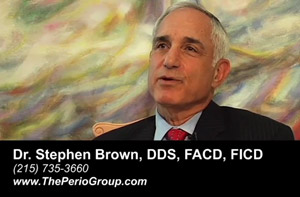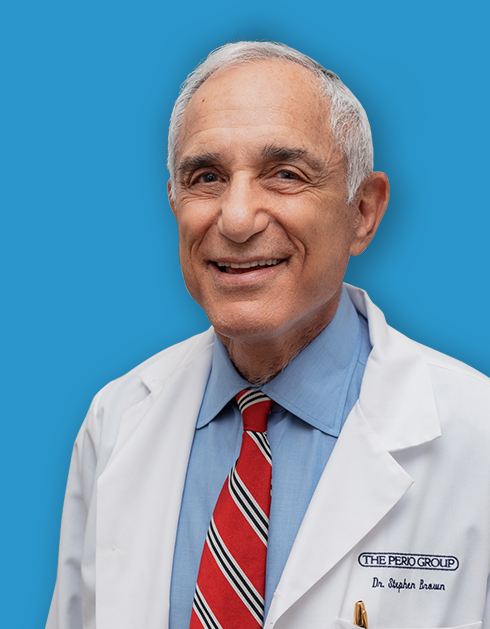Gum recession is the tooth root exposure due to a loss in the gum tissue. It can be caused by periodontal disease, trauma, or aggressive brushing and flossing. Gum recession may seem like a minor cosmetic issue, but it is an open gateway for bacteria to enter and infect the gums and jawbone. If not treated immediately, this can lead to severe periodontal disease and tooth loss. The first possible treatment for gum recession is usually an attempt to save the remaining healthy teeth with a less invasive procedure called soft tissue grafting.
Most patients don’t notice advanced gum recession until there’s an apparent gap between their teeth and gums. At this point, most patients usually decide they need soft tissue grafting. When the gums don’t cover the roots of the teeth, this exposes them to potential bacterial infections. If not treated, gum recession can lead to further damage, including bone exposure.
Trust Your Oral Health to Top Periodontist,
Dr. Stephen Brown.
Winner of over 350 awards during 40 years of excellence service.
Unfortunately, soft tissue grafting cannot be done at home. It requires a procedure by an experienced periodontist, someone who specializes in the treatment of gums and other soft tissues surrounding the teeth.
Soft tissue graft procedures are most often recommended for patients experiencing moderate to severe gum recession close to or involving more than one tooth. They are also often suggested for when deep pockets are found during an evaluation by a periodontist.
What Is Soft Tissue Grafting?
Soft tissue grafting is a medical-grade skin graft that helps cover exposed root surfaces and reduces pocket depths to halt further damage caused by gum recession or bone loss. This minimally invasive procedure that takes roughly an hour to complete involves repositioning the gum tissue to regenerate new cells. It restores the form and function of damaged gums, which leads to healthier teeth and improved appearance over time.
Types of Soft Tissue Grafting
Several types of soft tissue grafts can be used to treat gum recession. The type of soft tissue grafts your periodontist uses depends on the patient’s condition and needs. Your periodontist is the only practitioner who can determine what is right for you, so be sure to consult with an expert if you are experiencing gum recession.
Here are some types of soft tissue grafting.
Free Gingival Grafts
Free gingival grafting uses healthy gum tissue taken from the roof of a patient’s mouth and sewn onto an exposed root surface. This graft has a high success rate among all soft tissue grafts. The free gingival graft procedure can be used in areas with no recession where a hole needs to be closed or used in conjunction with other procedures such as connective tissue grafts. Your periodontist will let you know which type of soft tissue grafting procedure is best for your condition.
Pedicle Flap Grafts
Pedicle flap grafting uses a section of healthy gum tissue sewn into position via a surgical technique. This procedure is used to get around areas where the gum line has receded too far back for connective or free gingival grafts to be performed effectively. This can help close up more significant gaps in the patient’s mouth.
Allografts
An allograft is cadaver tissue harvested from another person and transplanted into a patient’s gum tissues. Allografts help treats severe periodontitis cases because they help fight off infection by keeping harmful bacteria out of the body.
One method involves taking tissue from an autopsy donor with the same blood type as the recipient patient. The other way is to replicate allograft skin tissue in a lab with compatible DNA. The latter option is considered more successful than the former because it comes from a patient’s own body.
What to Expect After Treatment
Once the procedure is completed, patients can expect their gums to be swollen and tender – or even numb – for about seven days. You must not brush or floss near the treated area during this time because it needs time to heal.
Periodontists recommend using warm salt water washes after two weeks have passed. The sutures used in soft tissue grafting are designed to dissolve over time, so there is no need to remove them yourself. Once they dissolve, you should notice the improved sensation in the affected areas because nerves have begun regenerating. Your periodontist will carefully monitor your gum health after your soft tissue grafting to ensure the treatment is successful.
The Benefits of Soft Tissue Grafting
There are benefits associated with getting soft tissue grafting for periodontitis. They include:
Prevention of tooth loss
The goal of any treatment is to prevent tooth loss caused by infection or damage due to advanced gum recession. Most patients won’t have their surgical procedure until it’s obvious they need one, so early detection can help you keep as many teeth as possible.
Improved gum health
Most patients who experience gum recession do so because their gums are unhealthy and susceptible to infection. Soft tissue grafting creates a favorable condition for healthy tissue growth, which means you’ll be able to keep more teeth as they age.
Improved appearance
Healthy gums make the teeth appear longer and brighter, improving the overall look of your smile. Additionally, good oral hygiene will give you an attractive, youthful tooth color that makes wearing makeup more straightforward than ever before.
Improved chewing and eating ability
Patients with severe periodontitis might have difficulty chewing food since certain foods pose a problem for exposed root surfaces. Soft tissue grafts help protect the areas where gum tissue has been removed, allowing patients to chew and swallow hard-to-chew items easily.
Get the Treatment You Need
If you’re suffering from periodontitis, your first step should be to contact The Perio Group in Philadelphia, PA. Dr. I. Stephen Brown is one of the most experienced periodontists in Philadelphia with over four decades of experience treating patients with gum disease and performing soft tissue grafting procedures to reverse damage caused by gum recession or other problems that lead to tooth loss.
To learn more about our services, contact us or schedule an appointment with Dr. Brown today!


